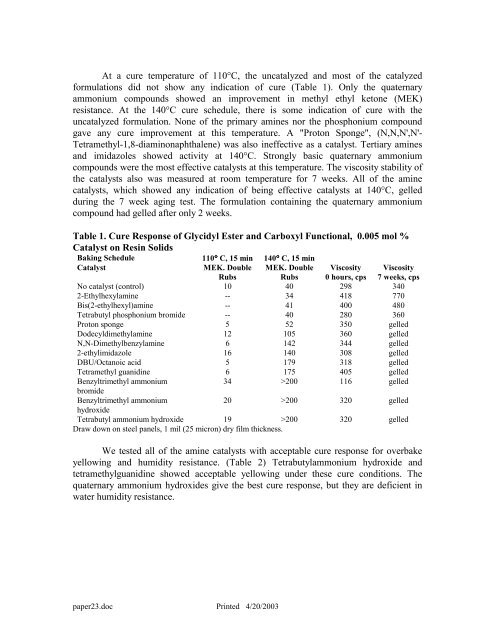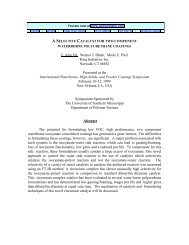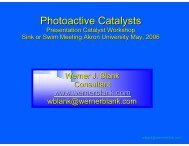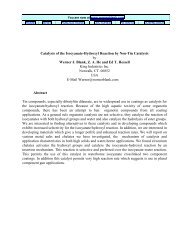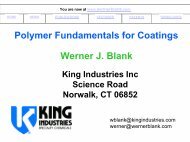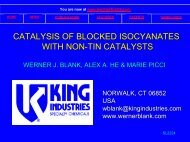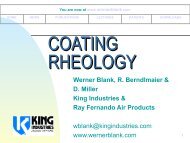Catalysis of the Epoxy-Carboxyl Reaction - Werner Blank
Catalysis of the Epoxy-Carboxyl Reaction - Werner Blank
Catalysis of the Epoxy-Carboxyl Reaction - Werner Blank
You also want an ePaper? Increase the reach of your titles
YUMPU automatically turns print PDFs into web optimized ePapers that Google loves.
At a cure temperature <strong>of</strong> 110°C, <strong>the</strong> uncatalyzed and most <strong>of</strong> <strong>the</strong> catalyzed<br />
formulations did not show any indication <strong>of</strong> cure (Table 1). Only <strong>the</strong> quaternary<br />
ammonium compounds showed an improvement in methyl ethyl ketone (MEK)<br />
resistance. At <strong>the</strong> 140°C cure schedule, <strong>the</strong>re is some indication <strong>of</strong> cure with <strong>the</strong><br />
uncatalyzed formulation. None <strong>of</strong> <strong>the</strong> primary amines nor <strong>the</strong> phosphonium compound<br />
gave any cure improvement at this temperature. A "Proton Sponge", (N,N,N',N'-<br />
Tetramethyl-1,8-diaminonaphthalene) was also ineffective as a catalyst. Tertiary amines<br />
and imidazoles showed activity at 140°C. Strongly basic quaternary ammonium<br />
compounds were <strong>the</strong> most effective catalysts at this temperature. The viscosity stability <strong>of</strong><br />
<strong>the</strong> catalysts also was measured at room temperature for 7 weeks. All <strong>of</strong> <strong>the</strong> amine<br />
catalysts, which showed any indication <strong>of</strong> being effective catalysts at 140°C, gelled<br />
during <strong>the</strong> 7 week aging test. The formulation containing <strong>the</strong> quaternary ammonium<br />
compound had gelled after only 2 weeks.<br />
Table 1. Cure Response <strong>of</strong> Glycidyl Ester and <strong>Carboxyl</strong> Functional, 0.005 mol %<br />
Catalyst on Resin Solids<br />
Baking Schedule 110° C, 15 min 140° C, 15 min<br />
Catalyst MEK. Double MEK. Double Viscosity Viscosity<br />
Rubs<br />
Rubs 0 hours, cps 7 weeks, cps<br />
No catalyst (control) 10 40 298 340<br />
2-Ethylhexylamine -- 34 418 770<br />
Bis(2-ethylhexyl)amine -- 41 400 480<br />
Tetrabutyl phosphonium bromide -- 40 280 360<br />
Proton sponge 5 52 350 gelled<br />
Dodecyldimethylamine 12 105 360 gelled<br />
N,N-Dimethylbenzylamine 6 142 344 gelled<br />
2-ethylimidazole 16 140 308 gelled<br />
DBU/Octanoic acid 5 179 318 gelled<br />
Tetramethyl guanidine 6 175 405 gelled<br />
Benzyltrimethyl ammonium<br />
bromide<br />
34 >200 116 gelled<br />
Benzyltrimethyl ammonium<br />
hydroxide<br />
20 >200 320 gelled<br />
Tetrabutyl ammonium hydroxide 19 >200 320 gelled<br />
Draw down on steel panels, 1 mil (25 micron) dry film thickness.<br />
We tested all <strong>of</strong> <strong>the</strong> amine catalysts with acceptable cure response for overbake<br />
yellowing and humidity resistance. (Table 2) Tetrabutylammonium hydroxide and<br />
tetramethylguanidine showed acceptable yellowing under <strong>the</strong>se cure conditions. The<br />
quaternary ammonium hydroxides give <strong>the</strong> best cure response, but <strong>the</strong>y are deficient in<br />
water humidity resistance.<br />
paper23.doc Printed 4/20/2003


